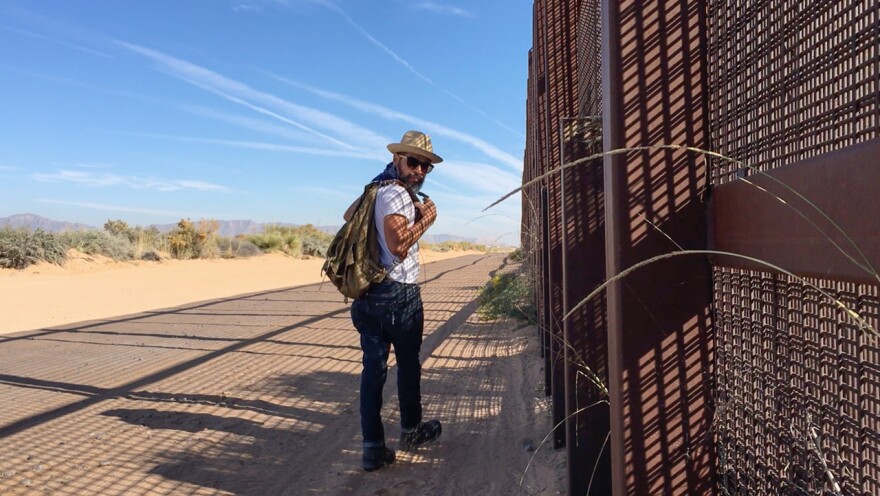Over the last few weeks, as Kansas City artist Israel Garcia made his way through Texans' backyards to the barrier that divides the United States from Mexico, he imagined everyone in the neighborhood would be well-versed on immigration policy.
"My assumption was if this border fence is your backyard fence that you’d be completely informed. Like you knew the ins and outs, you knew the politics, you knew how it all works," the Mexico native says.
Instead, what he found on his recent 2,000-mile trek along the border, was that even people — from all demographics and political leanings — who stared at the fence every day were only repeating talking points from the news the way many people do in Kansas City.
Garcia, proprietor of Garcia Squared Contemporary in the Crossroads, hiked and drove along the border from late October through the second week of December with the help of a Rocket Grant from the Charlotte Street Foundation and the Spencer Museum of Art.
The artist wanted to have his eyes on the situation so he could increase understanding of the migration, among Kansas Citians in general as well as in the particular immigrant community of which he’s a part.
"I really wanted people to understand what the journey entails, what you weren't exposed to what you didn't know about how people are risking their lives to get to a better future for themselves, for their families, putting children at risk," Garcia says.
In his travels, Garcia saw it all: well-guarded open spaces between the countries, high steel walls, and unattended openings that anyone could walk through unnoticed, but where he saw no one actually pass.
He also saw enormous crowds of migrants in lines that seemed to stretch miles. He saw weather-beaten families denied a chance to enter legally.

Garcia, who became a U.S. citizen this year, remembers when his family crossed into California from Tijuana. He says he knows that those who were denied entry will instead enter illegally and immediately surrender to authorities, even though they assume their request for asylum would subsequently be denied.
"I understood that once they got to the U.S. border it wasn't easy to turn back. If it wasn't going to be in a legal way, you had to find a way, because you've already put your life at risk for a month and your child's," he says. "To get to the border you have indebted yourself hugely just to make that journey through Mexico."
At the same time as Garcia was taking pictures and documenting what he saw, 7,000 migrants were traveling 4,000 miles, many of them on foot, in the so-called caravan heading for the United States border. And he heard residents in border neighborhoods refer to them as disease-ridden, or criminals who had the option of returning to their homes in Guatemala, El Salvador, and Honduras.
In late October, President Donald Trump deployed several thousand active duty and National Guard troops to the border in order, he said, to stop illegal immigration into the U.S. By the time Garcia returned to Kansas City, however, many service members had been sent home, including those from Fort Riley, Kansas, with the exception of 977th Military Police Combat Support, which will remain through January.

Until November 9, no one who entered illegally would be granted asylum due to the alteration of a rule by the current administration. A federal judge found the alteration in violation of the 1965 Immigration and Nationality Act and overruled it. More recently, on December 19, a federal judge ruled that the Trump administration had also violated federal law by barring migrants from requesting asylum based on domestic violence or gang violence, which is what many in the caravan hope to do.
Even though he'd already lived the struggle to attain a better life through great sacrifice, seeing it play out for others made a deep impression on Garcia. He’ll share that with Kansas City.
He gathered discarded artifacts of the migrants' journeys, mostly through dangerous desert terrain. He found backpacks, cloth booties that wouldn’t leave footprints, camouflage clothing, and water jugs. He'll present the found items this coming fall in a mobile museum in neighborhoods around Kansas City with high Latino populations. He means the display as a "symbolic gesture that will bring the U.S.-Mexico border home."

Garcia says this particular work is important for the metro's immigrant community to see, because he's observed a disconnect. Established immigrants in Kansas City don't necessarily know the history of their own migration, especially if their families have been in the area since the construction of the railroads in the 1800s, he says.
Furthermore, Garcia says, established immigrants are not connecting their own stories to those of people who are just arriving. So, like many other Kansas Citians, they don’t really feel the suffering or the hope of those seeking asylum.
"We actually have a history in Kansas City, we as people of color, migrants," he says. "We've had a presence here in Kansas City for over 150 years."
The history he refers to isn't specific to Kansas or Missouri; every city and town in the U.S. has some migrant history, whether or not it remains at the forefront of their thoughts as they read the news.
"I think that one of the things (immigrants) are continuously told is, 'Go back home.' I think (this project) was me coming back to them saying: This is home."
Follow KCUR contributor Anne Kniggendorf on Twitter, @annekniggendorf.




